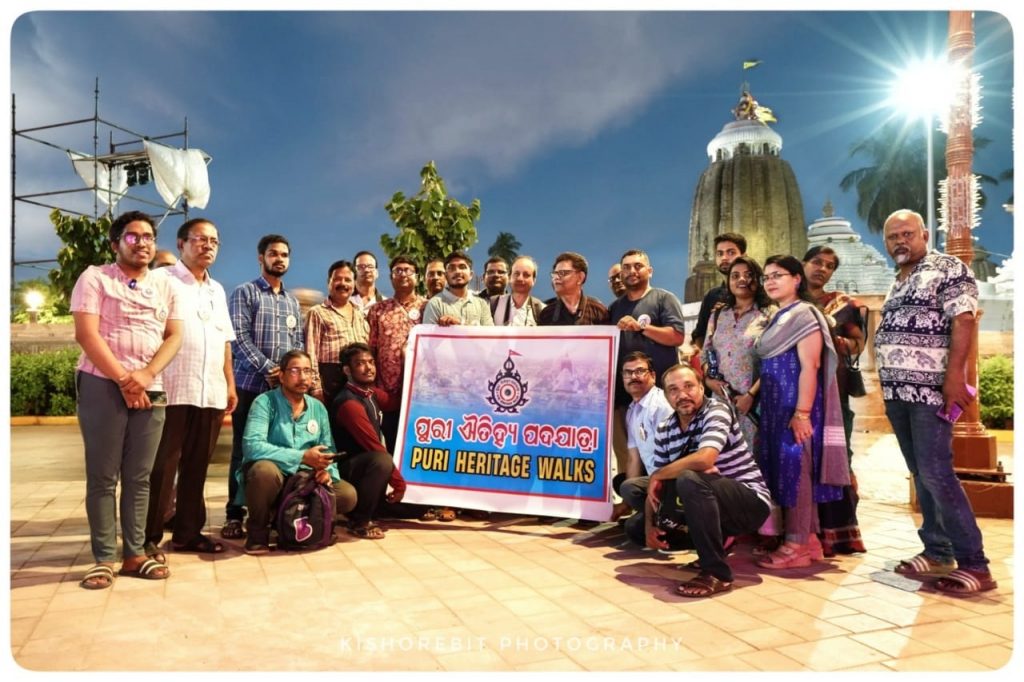Bhubaneswar: The essence of Jagannath Culture lies in a beautiful collage of philosophies under Vaishnavism, Shaivism, Shakta Upasana, Buddhism, Tantricism, and Sikhism while its beautiful reflection is seen in the ‘Goshani Jatra’ which is celebrated during Durga Puja. To be part of this beautiful socio-religious-cultural tradition of the Holy City, the Puri Heritage Walks (PHW) group organised a ‘Goshani Walk’ Sunday with participation of more than 30 heritage enthusiasts from various parts of the state.
According to religious texts, the origin of ‘Goshani Jatra’ dates back to around 12th Century AD, almost when the Srimandir was built. The chief ‘Goshani’ ‘Kakudikhai’ is a representative of Goddess Bimala.
However, while the immersion of all the ‘Goshani’ deities are made on ‘Ekadashi’ day, only the idol of Kakudikhai is immersed on ‘Dashami’ as it is done for Goddess Durga. The biggest ‘Goshani’, however, is Barabati and she is regarded as the elder sister of ‘Kakudikhai’. Mythology experts opine that ‘Goshani’ is a unified goddess of goddess Lakshmi, Saraswati and Kali. However, idols of Ganesh, Kartik, Ganga and Yamuna are also seen near the deity. The unique ‘Goshani’ culture is indigenous to Puri and the tradition is nowhere seen in any part of Odisha or India. The statues are also made out of clay and decorated with Kalingan style ornaments and the look of the goddess and the demon king Mahisasura is also unique to the Puri ‘Goshani’ style and the images radiate an aura of war-based body language and postures. At the end of the heritage walk, senior priest of Puri Srimandir Sidheswar Mohapatra, also the author of ‘Puri Boli’ narrated how “Goshani Jatra” has originated and become an annual celebration and ritual of the present status. He added that the word ‘Goswamini’ in Sanskrit or Odia has later been converted to ‘Goshamani’ and then to ‘Goshani’ with colloquial and local usage.
Get Latest Updates on Odisha Culture and News
Among the prominent heritage walkers of Sunday evening’s ‘Goshani Walk’ under PHW, convener of Cuttack Heritage Walk (CHW) author, historian and heritage enthusiast Dipak Samantrai, ace photographer and member of CHW Kishore Bit, senior members of PHW and CHW were present and they enjoyed every bit of the ‘Goshani Jatra’ which culminated near the Srimandir Monday evening before their immersion. While the annual Durga Puja brings the celebration of the rituals and worship of Maa Durga, in the Holy City of Puri, the ‘Goshanis’ take the centre stage and are called with loving local names as they have such an ancient origin and socio-cultural genesis. According to the Hindu tradition, starting from ‘Ashwina Krushna Paksha Mulastami’ upto ‘Shukla Paksha Navami’ the beautiful, vibrant and traditional rituals continue for 16 long days. The devotees and worshipers have the opportunity of viewing ‘Goshani’ idols representing various forms of ‘Maa Kakudikhai’, ‘Barabati’, ‘Janhikhai’, ‘Sunya Goshani’, ‘Belabai’, ‘Gelabai’, and several others.
The festival also features the display of other significant idols such as ‘Nagas, ‘Sampati Chadhei’, ‘Budha-Budhi’, ‘Dasamundia Ravana’, and many more. Interestingly, ‘Nagas’ involved in the traditional safety and security of the Srimandir through the learning of martial art practices at the ‘Jaga Ghara’ had their origin from Khalsa sect under Sikhism as the Puri Shree Jagannath Temple and their presence at the ‘Goshani Jatra’ represent the pan-Indian and rather a universal acceptance and association of the Jagannath culture and tradition.
ARINDAM GANGULY, OP
